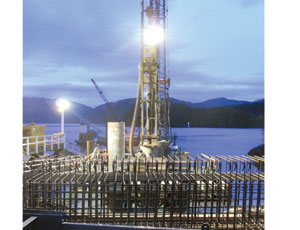Testing didn’t reveal it, but reality showcased it when crews started drilling piles for a new $3.2-million Lax Kw’alaams ferry dock in Port Simpson, British Columbia, completed last month. The “piles were walking,” says Claudio Pirillo, project manager for Prince Rupert, B.C.,-based Broadwater Industries.

A new dock will accommodate the 15-vehicle Spirit of Lax Kw’alaams’ ferry and offices for B.C.’s Ministry of Forests and Range. To build it, crews were to drill and socket 12 35-in.-diam steel piles 4 meters deep into bedrock for a ramp to the floating-barge dock. Test piles were driven into areas that showed few issues, but once construction started, sloping bedrock and a lack of overburden made positioning the piles on the 45� slope difficult.
“We found out when we started drilling,” Pirillo says. “A lack of overburden played a significant factor in holding the casing in position—that and the slope of the bedrock. The piles kept wanting to walk on us.”
“We knew the rock was sloping, but we didn’t realize it was that steep,” he adds. “You try to do the best job possible with the designs. Two piles happened to be outside the test location.”
The problem occurred on less than a handful of the 12 piles. Drilling crews from Duncan, B.C.-based Construction Drilling sent cables down to the seabed and hooked them to anchors on shore to hold the piles in place.
Along with the barge dock, a new 15-meter steel-girder bridge with a timber deck that connects the roadway—recently expanded from two to three lanes—to a 25-m timber-deck ramp. The ferry will berth against the barge. By adding a new dock, ferry travel time between Tuck Inlet and Prince Rupert is cut by 60 minutes. The project kicked off in December 2009.



Post a comment to this article
Report Abusive Comment